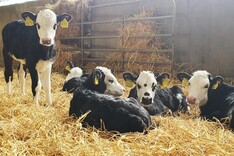With spring-calving cows housed, many farmers will be thinking about weaning calves. Weaning in the shed offers herd owners greater control over the cow’s diet and managing the associated health risks for cow and calf.Mastitis can be one such problem post-weaning and can lead to cows losing quarters. The incidence of mastitis will be reduced by gradual weaning, feeding cows low-quality forage for a short period and hygiene in the shed.
With spring-calving cows housed, many farmers will be thinking about weaning calves. Weaning in the shed offers herd owners greater control over the cow’s diet and managing the associated health risks for cow and calf.
Mastitis can be one such problem post-weaning and can lead to cows losing quarters. The incidence of mastitis will be reduced by gradual weaning, feeding cows low-quality forage for a short period and hygiene in the shed.
Gradual weaning means restricting the calf from suckling. This should be done over the course of at least one week. Cows with greater milk ability will need longer.
Start by locking the calf in the creep pen, giving access to the cow for one hour in the morning and again in the evening.
After a couple of days, reduce this access to once per day. At the end of the week, the calf should be locked off the cow completely.
Keep an eye for cows sucking other cows. The sucking effect will encourage cows to keep milking rather than dry off and allow the teat canals to close properly.
Diet
During this time, the cow should be eating a low-quality forage like straw, hay, or a high-fibre silage to lower milk production.
Be mindful that cows carrying strong body condition will utilise body reserves to maintain milk yield, even when offered straw.
Therefore, continue to feed a low-quality forage for a short period after weaning until you are happy the udder is empty.
Hygiene
If cows are housed on slats, run a hand-scraper over the pen once daily to reduce the amount of faeces coming in contact with the udder.
Clipping the cow’s tail will also help to keep the udder clean. Straw bedding should be dry and clean, so keep topping as necessary.
If a cow has mastitis, secure the animal in the crush, strip out the quarters and treat accordingly.
Read more
TB control ‘not working’ as costs set to hit €1bn over 10 years - TD
Farmer Writes: winter has arrived in Leitrim





SHARING OPTIONS: